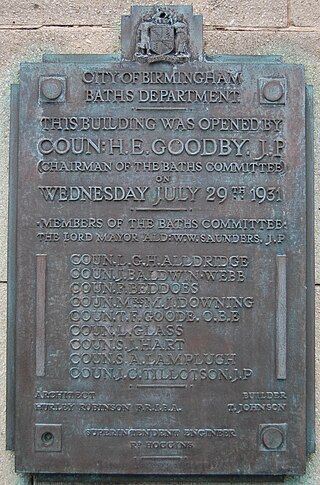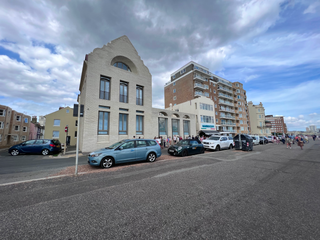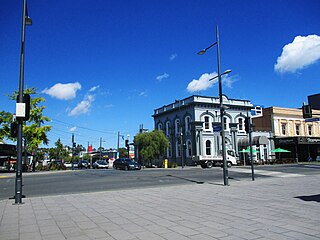
Bath is a city in the Bath and North East Somerset unitary area in the county of Somerset, England, known for and named after its Roman-built baths. At the 2021 Census, the population was 101,557. Bath is in the valley of the River Avon, 97 miles (156 km) west of London and 11 miles (18 km) southeast of Bristol. The city became a World Heritage Site in 1987, and was later added to the transnational World Heritage Site known as the "Great Spa Towns of Europe" in 2021. Bath is also the largest city and settlement in Somerset.

Rotorua is a city in the Bay of Plenty Region of New Zealand's North Island. The city lies on the southern shores of Lake Rotorua, from which it takes its name. It is the seat of the Rotorua Lakes District, a territorial authority encompassing Rotorua and several other nearby towns. Rotorua has an estimated resident population of 57,900, making it the country's 12th largest urban area, and the Bay of Plenty's second largest urban area behind Tauranga.

The Roman Baths are well-preserved thermae in the city of Bath, Somerset, England. A temple was constructed on the site between 60 and 70 AD in the first few decades of Roman Britain. Its presence led to the development of the small Roman urban settlement known as Aquae Sulis around the site. The Roman baths—designed for public bathing—were used until the end of Roman rule in Britain in the 5th century AD. According to the Anglo-Saxon Chronicle, the original Roman baths were in ruins a century later. The area around the natural springs was redeveloped several times during the Early and Late Middle Ages.

Heritage New Zealand Pouhere Taonga is a Crown entity with a membership of around 20,000 people that advocates for the protection of ancestral sites and heritage buildings in New Zealand. It was set up through the Historic Places Act 1954 with a mission to "...promote the identification, protection, preservation and conservation of the historical and cultural heritage of New Zealand" and is an autonomous Crown entity. Its current enabling legislation is the Heritage New Zealand Pouhere Taonga Act 2014.

The National War Memorial of New Zealand is located next to the Dominion Museum building on Buckle Street, in Wellington, the nation's capital. The war memorial was dedicated in 1932 on Anzac Day in commemoration of the First World War. It also officially remembers the New Zealanders who gave their lives in the South African War, World War II and the wars in Korea, Malaysia and Vietnam.

Te Arawa is a confederation of Māori iwi and hapu of New Zealand who trace their ancestry to the Arawa migration canoe (waka). The tribes are based in the Rotorua and Bay of Plenty areas and have a population of around 60,117 according to the 2018 census making it the 6th biggest iwi in New Zealand. The Te Arawa iwi also comprises 56 hapū (sub-tribes) and 31 mārae.

The Birmingham Baths Committee was an organisation responsible for the provision and maintenance of public swimming and bathing facilities. Birmingham City Council funded, constructed and ran bathing facilities throughout the city. The movement to develop baths and wash houses in Britain had its impetus with the rapid urbanisation of the Industrial Revolution, which was felt acutely in Birmingham, one of England's powerhouses.

Medina House is a former Turkish bath on the seafront of Hove, Sussex, England. After falling into disuse it was squatted for several years. During this period Sirus Taghan, the then owner, agreed that the occupants could remain so long as the property was kept in the same condition as before occupation. The squatters were eventually evicted in September 2006, although the property was re-occupied for a week at the end of January 2007.

Tamati Gerald Coffey is a list Member of the New Zealand Parliament for the New Zealand Labour Party. Prior to entering Parliament, he was most notably an award-winning broadcaster fronting many shows over a decade, for Television New Zealand. He was also a successful small business hospitality owner in his hometown of Rotorua for 7 years, including during the COVID-19 pandemic, before selling in 2022. He is also a father, having had a baby through gestational surrogacy with his partner.

Hamilton Central is the central business district of Hamilton, New Zealand. It is located on the western banks of the Waikato River.

Cleveland Pools located in Hampton Row, Bath, Somerset, England is a semi-circular lido built to designs by John Pinch the Elder in 1815. It is believed to be the oldest public outdoor swimming pool in England. It is a Grade II* listed building.
Polynesian Spa is a developed geothermal spa facility in Rotorua, North Island, New Zealand.

The Rotorua Museum Te Whare Taonga o Te Arawa is a local museum and art gallery in the Government Gardens near the centre of Rotorua, New Zealand.

The Government Gardens is a public park, partly laid out as gardens, located beside Lake Rotorua in central Rotorua, Bay of Plenty, North Island, New Zealand. It was built by the government as a tourism attraction, and is still a major tourism destination in New Zealand.
John Thomas Mair was a New Zealand architect. From 1923 until his retirement in 1941 he held the position of Government Architect.

Bath and North East Somerset is a unitary authority created on 1 April 1996, following the abolition of the County of Avon, which had existed since 1974. Part of the ceremonial county of Somerset, Bath and North East Somerset occupies an area of 220 square miles (570 km2), two-thirds of which is green belt. It stretches from the outskirts of Bristol, south into the Mendip Hills and east to the southern Cotswold Hills and Wiltshire border. The city of Bath is the principal settlement in the district, but BANES also covers Keynsham, Midsomer Norton, Radstock and the Chew Valley. The area has a population of 170,000, about half of whom live in Bath, making it 12 times more densely populated than the rest of the area.

There are over 670 scheduled monuments in the ceremonial county of Somerset in South West England. The county consists of a non-metropolitan county, administered by Somerset County Council, which is divided into five districts, and two unitary authorities. The districts of Somerset are West Somerset, South Somerset, Taunton Deane, Mendip and Sedgemoor. The two administratively independent unitary authorities, which were established on 1 April 1996 following the breakup of the county of Avon, are North Somerset and Bath and North East Somerset. These unitary authorities include areas that were once part of Somerset before the creation of Avon in 1974.

Wellington Central Library is a public library building in the central business district of Wellington, in New Zealand. It is owned by Wellington City Council and is listed as a Category 1 historic place by Heritage New Zealand. The building was opened in 1991 and was a key element of Wellington’s municipal centre, Te Ngākau Civic Square. It served as the main hub for the municipal library service, Wellington City Libraries.

BNZ Harbour Quays was a large office building on the waterfront in Wellington, New Zealand. It was built in 2009 and leased to the Bank of New Zealand, but suffered earthquake damage in the 2013 Seddon earthquake and the 2016 Kaikōura earthquake. The building was demolished in 2019.
Magic Playgrounds in New Zealand's Geyserland is a 1935 New Zealand promotional documentary film.


















